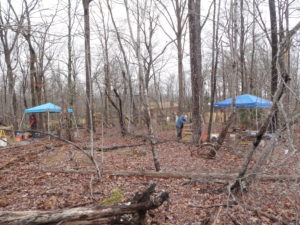Making Stone Tools the Hardaway: A Paleoindian Artifact from the Graceland Site, Randolph County, North Carolina
By Joe Blondino
It’s no surprise that archaeologists like old things. That’s why we get particularly excited when we find artifacts dating to the Paleoindian period, which spans from at least as early as 12,000 BC (Carr 2018, Carr and Adovasio 2002, Goodyear 2005) to approximately 8,000 BC (Ward and Davis 1999). This period represents the earliest occupation of North America, when people were settling into new environments that would ultimately shape the way their culture and technology evolved in different parts of the continent.
For September we will look at a Paleoindian artifact that continues our series highlighting materials recovered from the Asheboro Bypass Project in Randolph County, North Carolina. Among the sites identified during this project was the Graceland site (31RD1568). Dovetail Cultural Resource Group conducted excavations at this site on behalf of the North Carolina Department of Transportation (NCDOT), guided by the Scope of Work authored by NCDOT (Overton 2015) and coordination between Dovetail, NCDOT, and the North Carolina Office of State Archaeology. The majority of the 3,661 artifacts recovered from the site date to the Morrow Mountain and Guilford phases of the Middle Archaic period, spanning a date range from approximately 5,000 to 3,000 BC (Blondino and Proper 2018). However, a Hardaway side-notched point dating to the late Paleoindian period indicates that the site was being used much earlier. Excavations at the Slade site in southeastern Virginia suggest a date range of 8,250–8,050 BC for the Hardaway phase (McAvoy and McAvoy 1997), making these points approximately 10,000 years old!
The Hardaway point from the Graceland site is made of a metavolcanic rock common to this part of North Carolina and quarried by the prehistoric occupants of the site as a material from which to make projectile points and other stone tools. The site itself is located on a slight slope near a natural drainage which channels surface water during heavy rain. As a result, there is more erosion here than in nearby areas, exposing the bedrock and making it easier to get to. The distribution of artifacts across the site suggests that people were obtaining stone from near the drainage, where it could be found closer to the surface, and then taking it up to the flatter land above to work it into tools. Prehistoric people would visit sites like this when their stone toolkit was in need of rejuvenation. Stone tools like projectile points and knives can be re-sharpened, but this process removes material, and eventually the tool is too small to be used and simply must be replaced. It is likely that this was the case with the Graceland Hardaway point. You might notice from the photograph that the point is a little lopsided- if you look at the tip of the point, it is not directly above the center of the base. This often happens because the point has been re-sharpened more on one side than on the other, perhaps because it was being used more as a knife than as a projectile point. When its owner visited the Graceland site during the late Paleoindian period, they may have made themselves a new point (or a few of them), and simply discarded this one, only to have Dovetail archaeologists find it again 10,000 years later. Now that’s doing things the Hardaway!

Excavations at the Graceland site. The Hardaway point was recovered from the excavation unit under the canopy on the right.
Any distributions of blog content, including text or images, should reference this blog in full citation. Data contained herein is the property of Dovetail Cultural Resource Group and its affiliates.
References:
Blondino, Joseph R. and Earl E. Proper
2018 Addendum: Archaeological Survey and Testing of Newly Defined Areas of Potential Effects for the Asheboro Bypass, Randolph County, North Carolina. Dovetail Cultural Resource Group, Fredericksburg, Virginia.
Carr, Kurt
2018 Peopling of the Middle Atlantic: A Review of Paleoindian Research. In Middle Atlantic Prehistory: Foundations and Practice, edited by Heather A. Wholey, and Carole L. Nash, pp. 219–260. Rowman & Littlefield, Lanham, Maryland.
Carr, K.W., and J.M. Adovasio
2002 Paleoindians in Pennsylvania. In Ice Age Peoples of Pennsylvania, edited by Kurt Carr and James Adovasio, pp. 1–50. Recent Research in Pennsylvania Archaeology, No. 2. Pennsylvania Historical and Museum Commission, Harrisburg, Pennsylvania.
Goodyear, Albert C.
2005 Evidence of Pre-Clovis Sites in the Eastern United States. In Paleoamerican Origins: Beyond Clovis, pp. 103–112. Center for the Study of the First Americans, Texas A&M University, College Station, Texas.
McAvoy, Joseph M. and Lynn D. McAvoy
1997 Archaeological Investigations of Site 44SX202, Cactus Hill, Sussex County. Virginia Department of Historic Resources Research Report Series n. 8, Richmond, Virginia.
Overton, Brian
2015 Request for Proposal: Intensive Archaeological Survey and Evaluation, Asheboro U.S. 64 Bypass. North Carolina Department of Transportation, Human Environment Section, Raleigh, North Carolina.
Ward, H. Trawick, and R.P. Stephen Davis Jr.
1999 Time Before History: The Archaeology of North Carolina. The University of North Caroloina Press, Chapel Hill, North Carolina.

